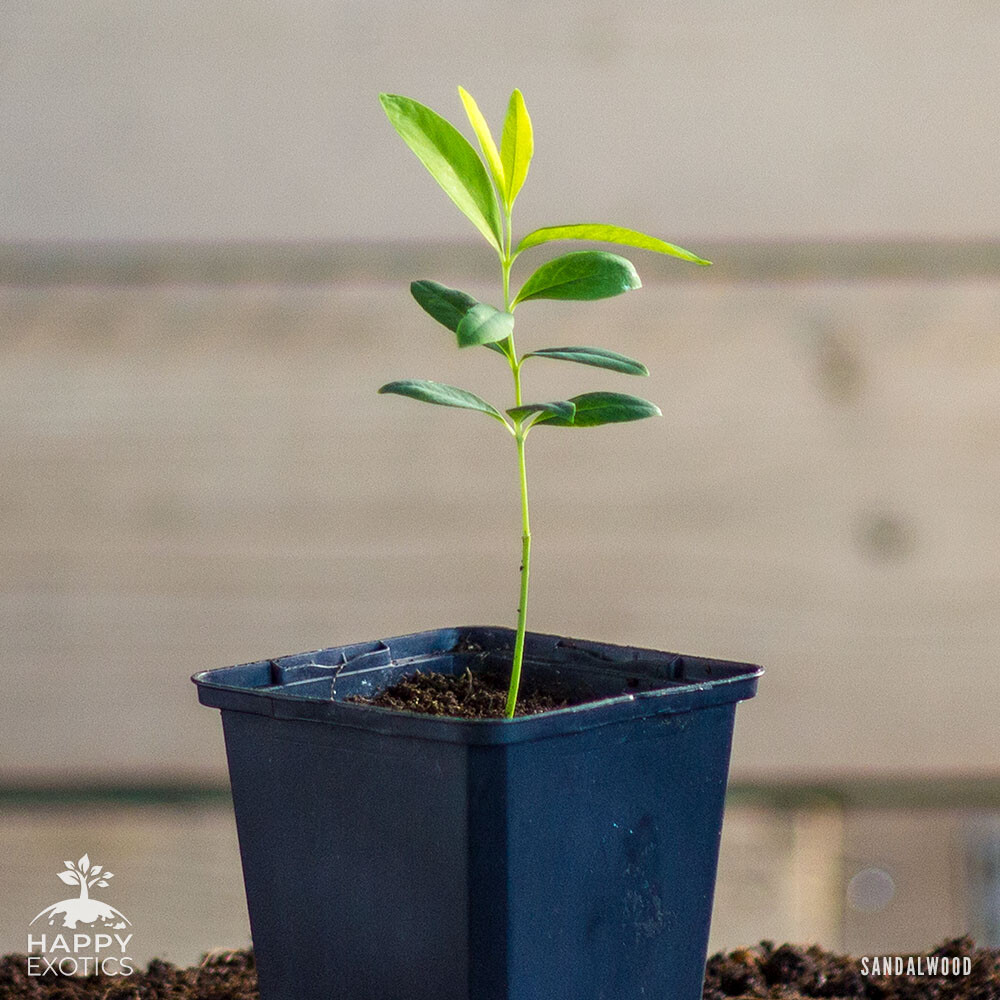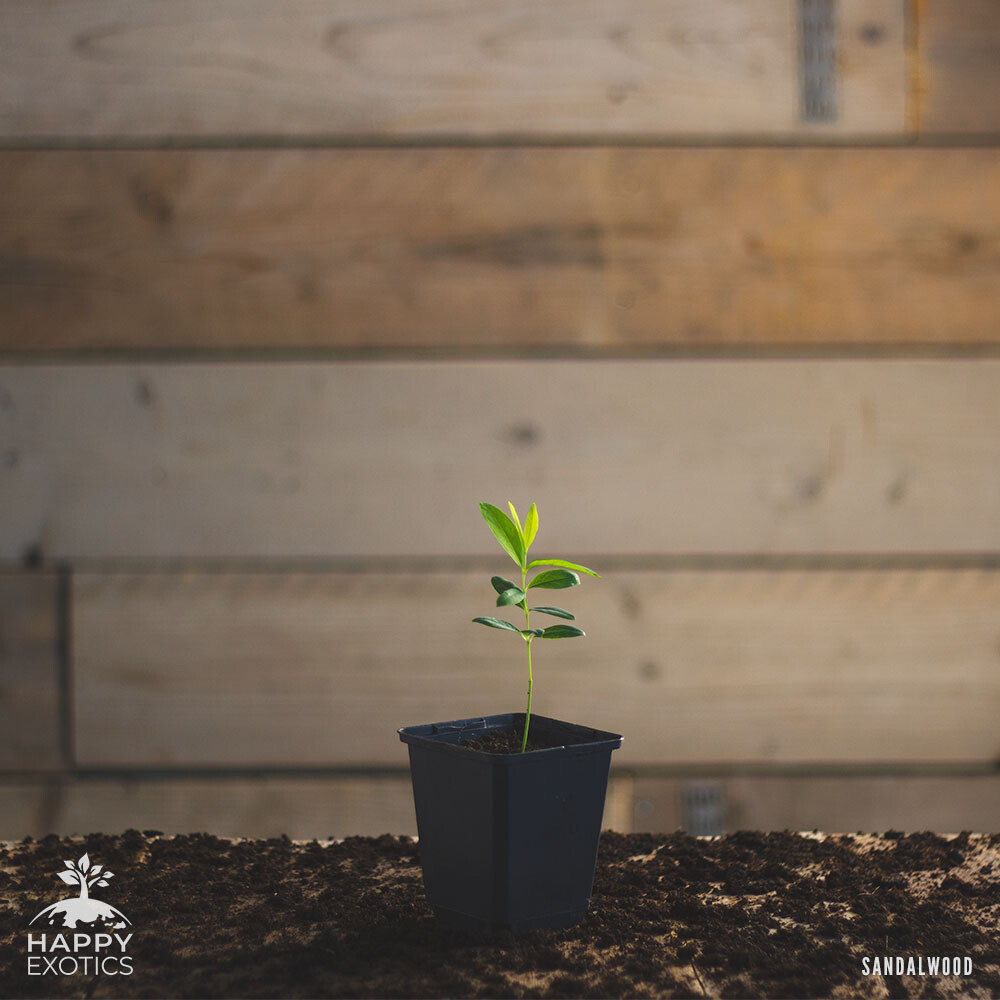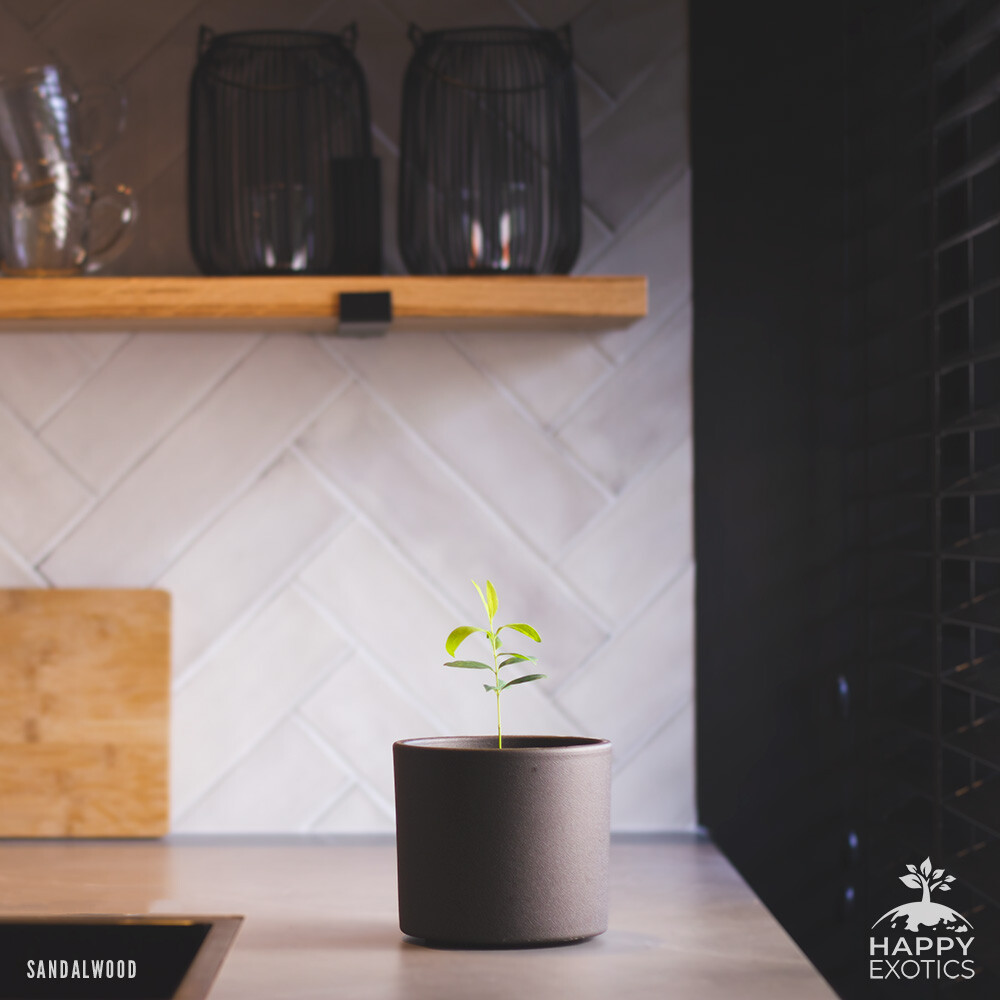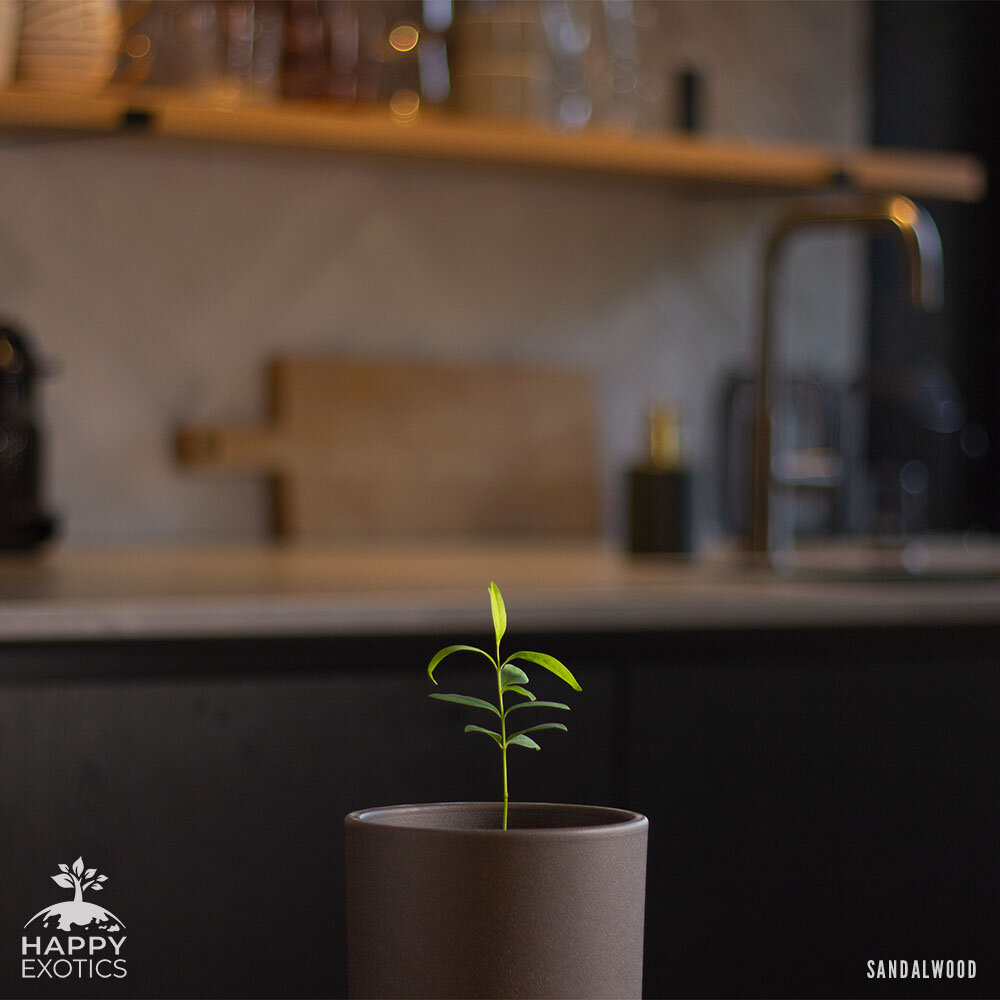1 super happy Sandalwood tree – Santalam Album
€24.95
Out of stock
Email when stock available

Fast EU shipping

Grown in our own nursery
The sandalwood tree, scientifically known as Santalum album, is a medium-sized evergreen tree that belongs to the family Santalaceae. It is native to the Indian subcontinent, particularly India, and is also found in parts of Southeast Asia, including Indonesia and Sri Lanka.
Sandalwood trees have a distinctive appearance with a straight trunk and a dense, symmetrical crown of foliage. They can reach a height of 8 to 12 meters and have a lifespan of around 60 to 80 years. The bark of the tree is smooth and grayish-brown in color.
The sandalwood tree is highly valued for its fragrant heartwood and has numerous uses. Here are some of the main uses of sandalwood:
- Perfume and fragrance: Sandalwood is renowned for its sweet, woody aroma. The heartwood is distilled to extract sandalwood essential oil, which is widely used in perfumes, colognes, and other fragrance products.
- Incense and spiritual practices: Sandalwood is burned as incense in various religious and spiritual practices. The rich and soothing fragrance is believed to promote relaxation, meditation, and enhance focus.
- Medicinal and Ayurvedic uses: Sandalwood has a long history of use in traditional medicine, particularly in Ayurveda. It is believed to have cooling, anti-inflammatory, and antiseptic properties. Sandalwood paste or oil is used for skin conditions, aromatherapy, and to promote mental well-being.
- Cosmetics and personal care products: Sandalwood is used in the cosmetic industry for its fragrance and beneficial properties. It is found in soaps, lotions, creams, and various skincare products.
- Woodcraft and carving: The fine-grained and durable nature of sandalwood makes it highly sought after for woodworking and carving. It is used to create intricate carvings, sculptures, furniture, and decorative items.
- Traditional ceremonies and rituals: Sandalwood is considered sacred in many cultures and is used in religious ceremonies, rituals, and festivals. It is used in the form of sandalwood powder, paste, or incense sticks.
The sandalwood tree has small, oval-shaped leaves that are dark green and leathery in texture. It produces small, inconspicuous flowers that are either pale yellow or purplish in color. These flowers give way to small, spherical fruits that contain a single seed.
Due to the high demand for sandalwood and unsustainable harvesting practices, many sandalwood populations have been significantly depleted, and the species is now considered threatened in its natural habitat. Conservation efforts and sustainable cultivation practices are being implemented to protect and restore sandalwood populations.
Additional information
| Weight | 0.4 kg |
|---|---|
| Dimensions | 32 × 17 × 10 cm |
Properties & Care
How to take care of a Sandalwood tree?
Growing a sandalwood tree in a pot can be a challenging task, as sandalwood trees typically prefer to grow in their natural habitat. However, if you’re willing to give it a try, here are some general guidelines:
- Choose a suitable pot and soil: Select a large pot with good drainage holes to allow excess water to escape. Use a well-draining potting mix that consists of a combination of sand, loam, and organic matter. The soil should be slightly acidic to replicate the natural conditions sandalwood prefers.
- Watering and care: Keep the soil moist but not waterlogged. Avoid overwatering, as it can lead to root rot. Provide regular watering and misting to maintain humidity levels, as sandalwood trees prefer a humid environment. However, allow the soil to dry slightly between waterings to prevent waterlogged conditions.
- Temperature and sunlight: Like most of our trees and plants, Sandalwood trees are subtropical and thrive in warm climates. Provide your potted sandalwood tree with ample sunlight, preferably in a location that receives partial shade. Protect it from extreme temperatures, frost, and strong winds.
- Pruning and fertilizing: Prune the tree occasionally to maintain its shape and remove any dead or damaged branches. Use a balanced fertilizer specifically formulated for woody plants to promote healthy growth.
- Patience and long-term care: Growing sandalwood in a pot requires patience, as it can take several years for the tree to reach a decent size. Ensure consistent care, including proper watering, fertilizing, and monitoring for pests or diseases.
Remember that sandalwood trees are slow-growing, and successful cultivation in a pot may be challenging.
FAQ
Propagation
Sandalwood trees can be propagated through seeds, stem cuttings, tissue culture, and grafting. Seeds are challenging to germinate, while stem cuttings and tissue culture are more reliable methods. Grafting allows for the production of genetically identical plants. Seeking guidance from experts is recommended for successful propagation.
Shipping & Returns
WARRANTY AND RETURNS
Despite the high quality of our products, it can occur that you receive a product that is not perfect. If that happens we’d like to provide you with a suitable solution as quickly as possible.
ALWAYS 2 YEARS WARRANTY
We are convinced of the quality of the products we offer. Therefore we always give 2 years guarantee on all your purchases.
14 DAY MONEY-BACK PERIOD
Curryelaftree.com operates a 14 day approval and inspection period for all online orders. This period starts when you have received the product. After 14 days the purchase agreement becomes final. During this period you should handle the product and packaging carefully, if reasonably possible. Try the product out to the extent necessary in order to decide whether you wish to keep it. The product can be vieuwd and reviewed, as you would do in a shop. When there is damage to the product or its packaging, this will be deducted from the return. When the product is used in this period, and now returned, the costs for use, such as cleaning or repair costs, will be deducted from the return. When you return a product within the 14 day money-back period, we are obliged to pay you the purchase price, including shipping and any debit or administration costs, back within 14 days from receiving your return.
DAMAGE UPON RECEIPT
All products are packaged safely and checked by Curryleaftree.com before shipping. If you nevertheless do receive a damaged product, please report the damage before returning the order.
RETURNS PROCEDURE
There are a number of reasons you may decide to return (a part of) your order. Read this information through carefully to avoid any misunderstandings and delays. If you wish to return a product, the method of shipment and the condition of the product must comply with our stated terms and conditions below.
Returns Form
For the return of a shipment contact us first. By filling in a form and sending it to us, you let us you know that you want to return your shipment. When we have received this form, we will start processing your return. You can always email us to discuss your return.
Return Shipment and Costs
The correct postal franking costs must always be paid for a return shipment. Packages not correctly franked or marked as returned subject to payment on delivery will not be accepted by us. Curryleaftree.com reimburses the postal costs after returning in case the return is a result of an mistake by Curryleaftree.com or when there is a defective product. If you are entitled to a refund of the shipping costs, we apply a maximum fee. You can also choose to bring the product back or exchange it at the Curryleaftree.com office. This is fast, easy and free of charge. The maximum fee for a return shipment is € 6,95 within the Netherlands, € 9,95 for Belgium and Germany, € 25.95 for the rest of Europe and € 29,00 for the rest of the world.
Return Address
Curryleaftree.com
Warranty and Returns
Tolweg 2W 3851 SK
Ermelo The Netherlands
Only logged in customers who have purchased this product may leave a review.





Reviews
There are no reviews yet.